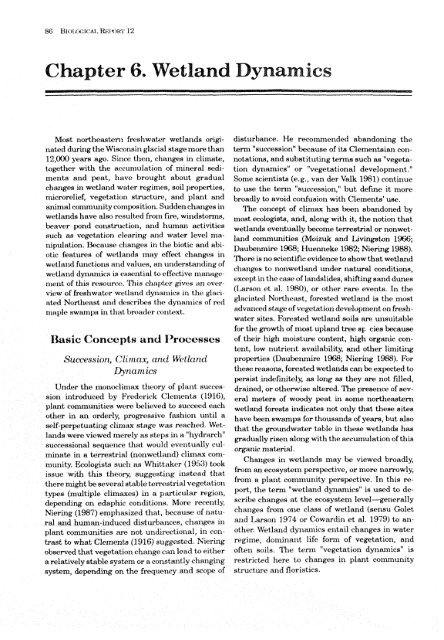Ecology of Red Maple Swamps in the Glaciated Northeast: A ...
Ecology of Red Maple Swamps in the Glaciated Northeast: A ...
Ecology of Red Maple Swamps in the Glaciated Northeast: A ...
Create successful ePaper yourself
Turn your PDF publications into a flip-book with our unique Google optimized e-Paper software.
Chapter 6. Wetland Dynamics<br />
Most nod hem ten^ freshwater wetlmda orig<strong>in</strong>ahd<br />
durixrg tho Wiscorrsilr~ glacial stage nmre than<br />
12,000 yeam ago. S<strong>in</strong>ce <strong>the</strong>n, cfisngea <strong>in</strong> clirnatrr,<br />
togat.har with tlre acct~xrlulation <strong>of</strong> nlirlernl scdidisturbru~ce.<br />
He recamnlexrded abandon<strong>in</strong>g thp<br />
term "auccession'bax~se <strong>of</strong> its Clemexrtsiml mxrnot,atiorts,<br />
and substitut<strong>in</strong>g kmli such as "vegetation<br />
dyxlmics" or "vegetational development."<br />
nlexlttl and peat, JI~c~vc brotrght. about gradual Some sciexlti~b (e.g., van der VnEk 1981) cantixliae<br />
changc~s <strong>in</strong> wekland watcr wg<strong>in</strong>ies, soil g>mlwrtit.s, Use tilt? kr?ll "~uc~ession," but def<strong>in</strong>e it more<br />
micrcmmlief, vcgctr?lation st.mcture, md plant and broadly ta avoid cotlf~xsion with Clexxiclnb' use.<br />
~gxxirnal cornmurxity cornpsition. Sudden changes ixl Tho concept <strong>of</strong> rIirY~ax has bee11 abmdoned by<br />
wetlands huve &]so reslllted fr01xl fire, wir~d~brnm, nlnst t?cologi~lst;s, and, along with it, <strong>the</strong> notion that<br />
beaver ~wnt3 cozxstrtlction, imd k1unisi11 activities wetlllulda everltudly beeonlo hrreakid or nonwet-<br />
H U ~ BN I vegc~t~xtior~ rlefirixig auld water It?vel ~ 11~-<br />
Imrd tomniunities QMoizuk arid Liv<strong>in</strong>gstun XSfi;<br />
xtipufrzt.iot1. lkausc changrs <strong>in</strong> tire biotic and abi-<br />
1)uukrunire 1968; E-iucxrncke 1982; Nierixlg 1988).<br />
r,t,ic fe~nt.urc~s <strong>of</strong> wt~tlnrlrls Inciy effiqt chlitrlgee <strong>in</strong><br />
't'herc? is no wiex~tific evidence ta show that wetlarrd<br />
wet land ftlrictiort~ aii~X VELILICR, iitl il~~tlt>rstwiciii~g <strong>of</strong><br />
rhangea tx, nonwetlmd under natural cunditiorm,<br />
wi~t.ie~t~d $ytlamir.~ is ~*s,rc*trt ird ta effwtivc? rtliitragrc-<br />
~xcept <strong>in</strong> <strong>the</strong> cnae <strong>of</strong> Iaxlctalides, shiftixy: sand dunr.a<br />
rrrrtit <strong>of</strong> tli<strong>in</strong> rer;ourc.t*. 'l%is cku~ptk~r givt" i1r1 owr<br />
(I~trwn 1.t EJ.<br />
vitaw nf fmsllwntrbr watlt<strong>in</strong>tf dyrl~illic8 <strong>in</strong> f ilv ~I:Ic+Lt980),<br />
or othclr ram everlts.. In <strong>the</strong><br />
plac<strong>in</strong>kti<br />
rttd Nort+itc*rrsil. arid d~'8cri~s tiic* dy~lsrui~~ <strong>of</strong> rd<br />
Nodhcaask,, forcstsc.cl watllluld is <strong>the</strong> moat<br />
mr*l~Ii: swantps <strong>in</strong> that trrortder cnntr*xt.<br />
rtatvar~ced B ~ W <strong>of</strong> ~ G vcage~tr~tt ion dstrelopmc~~t orr freshwat~r<br />
sib. Fareshd wetland ~oila ouc, uxmuitnble<br />
It$awie Coneopts and I3roc=cescs<br />
for tht* p41 <strong>of</strong> xrlaat upland txwe BF ~ ibixause<br />
e ~<br />
<strong>of</strong> thok high moistsure content, high arganic content,<br />
low xluLrierrt availability, and o<strong>the</strong>r iirnitiry~<br />
pm~.rcrties (Dnukrxmire 1968; Nier<strong>in</strong>g 1988). For<br />
tht~cae ri>atiPOne, fonsatcd wetlands can bc? exgwlcbd to<br />
gx>mist itldef<strong>in</strong>ik*ly, AB lorig as <strong>the</strong>y are not filled,<br />
Under <strong>the</strong> mr,skoc.l<strong>in</strong>l*x tlrclury <strong>of</strong> pl~l~lf SUL+CQB dra<strong>in</strong>ed, or o<strong>the</strong>rwise itlkmd. Tho preaeience <strong>of</strong> esvrsiara<br />
ilxkr~duced by Frodiirrick C:leniclhts (1!)1G), era1 nr~crturs <strong>of</strong> w d y peat kt aonie nor<strong>the</strong>mbmr<br />
plant eoxnmttniticla wen* iwlioved tcr awcc.t.c.d each wetland forests <strong>in</strong>rlicatetl not only that <strong>the</strong>se sites<br />
ot<strong>in</strong>rsr <strong>in</strong> ail nrtIerfy, ~~ro~essiv~ ftistlias~ tailti1 a have twn swampha for thousnxkcts <strong>of</strong> yem, but &so<br />
self-~wr~xttuatix~g cl<strong>in</strong><strong>in</strong>x st.agpl was rt3rilctxetf. %t- tilazt <strong>the</strong> ~rirrdwa@r kabic <strong>in</strong> tllesse wetlands hrz9<br />
ladw were vis;.wetI xnerely tis ~ if~qj~ <strong>in</strong> 81 "hyitrt~xI~'~ padually rkcn daxlg with tho nixtarnulation <strong>of</strong> this<br />
succt*~sionnl ~C~XIOI~C'C that would c*vet~tu~EIy cu1-<br />
organic material.<br />
ramttk* irz s CL'mes't~ia1 (KIQXLWC~~RX~~)<br />
C~~XX~HX I'CIIXLchctngca8<br />
ill wetla~ids ~~(rtty be viewed brorray,<br />
xrrnnit;4. EmIagiedr suctl rzs Whittnlcrl- (1953) took<br />
frr~nl iua ecosyskm @rswctivc, ar mare narrowly,<br />
issue with this tfrcory, skxgge&Cimlg <strong>in</strong>~trttd thxt<br />
front R plant corrlrnurliky pi.rsywctive. <strong>in</strong> this re<strong>the</strong>re<br />
might G sevtmd stab1 e terrcstr<strong>in</strong>l vc*gc%tat iott<br />
i,ypea (~rzultiplo elitnaes) ixl a particular n;g' a k ~ ~ r x port, ~ <strong>the</strong> brnr "wot,ltmd dpamica" is used to dedcpc3ndiirg<br />
on edsphic eonditioxrs, More rew~rrily,<br />
scribe changes at <strong>the</strong> wosystem level-gerierally<br />
Nicrlrng (1587) ernphasi~d that, because <strong>of</strong> natuchaxra~s<br />
front one? class <strong>of</strong> wetland (scnsu Golet<br />
rali a1.d hunr nnz-hduced dist~wirbnnccs, eharlgcs <strong>in</strong><br />
and Idarson 1974 or Gctwrrrd<strong>in</strong> et al. 2979) to ancarnuxities<br />
me zxot ~mndirectiotkal, <strong>in</strong> ~0x1-<br />
atfrer. Wetfnrxd cXyntu11ics entail changes <strong>in</strong> wahr<br />
trast ta what Cleme?x~fs (1916) strmested. Nieri~xg rrgime, dorn<strong>in</strong>arlt. life form <strong>of</strong> vewtation, and<br />
observed that vegetation change? em<br />
lead to ei<strong>the</strong>r <strong>of</strong>ten soils. The term "vegetation dynaice" is<br />
a ~Iatlvoly &.able syst~rn or a constantly cktnng<strong>in</strong>g restricted here to ch~nps <strong>in</strong> plant eo~mlukty<br />
system, depend<strong>in</strong>g on <strong>the</strong> frequency and $COP <strong>of</strong> strurtum md fioristics.

















